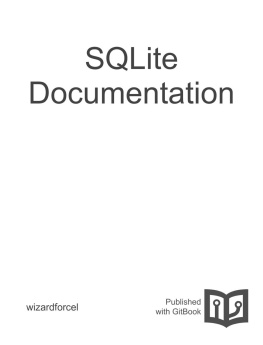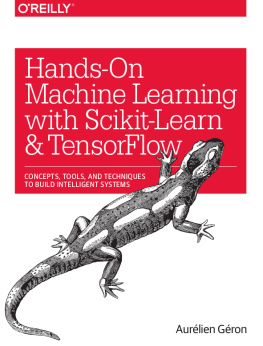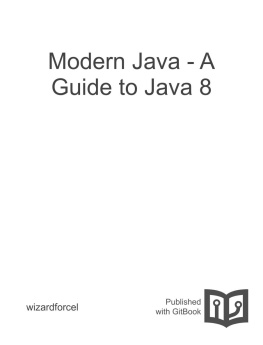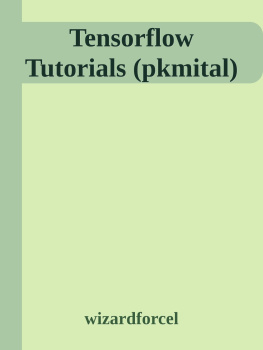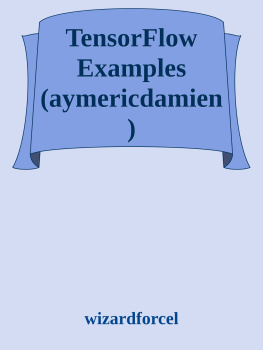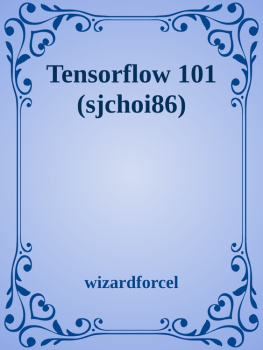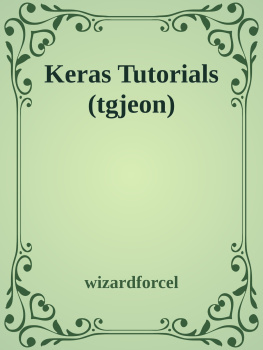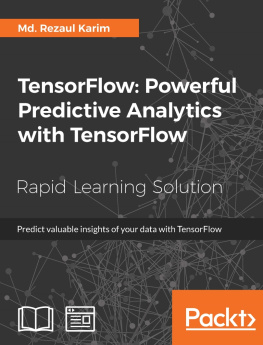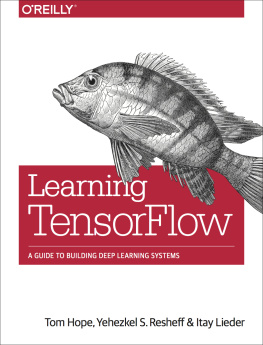it-ebooks - TensorFlow Tutorials (nlintz)
Here you can read online it-ebooks - TensorFlow Tutorials (nlintz) full text of the book (entire story) in english for free. Download pdf and epub, get meaning, cover and reviews about this ebook. year: 2018, publisher: iBooker it-ebooks, genre: Romance novel. Description of the work, (preface) as well as reviews are available. Best literature library LitArk.com created for fans of good reading and offers a wide selection of genres:
Romance novel
Science fiction
Adventure
Detective
Science
History
Home and family
Prose
Art
Politics
Computer
Non-fiction
Religion
Business
Children
Humor
Choose a favorite category and find really read worthwhile books. Enjoy immersion in the world of imagination, feel the emotions of the characters or learn something new for yourself, make an fascinating discovery.
- Book:TensorFlow Tutorials (nlintz)
- Author:
- Publisher:iBooker it-ebooks
- Genre:
- Year:2018
- Rating:5 / 5
- Favourites:Add to favourites
- Your mark:
- 100
- 1
- 2
- 3
- 4
- 5
TensorFlow Tutorials (nlintz): summary, description and annotation
We offer to read an annotation, description, summary or preface (depends on what the author of the book "TensorFlow Tutorials (nlintz)" wrote himself). If you haven't found the necessary information about the book — write in the comments, we will try to find it.
TensorFlow Tutorials (nlintz) — read online for free the complete book (whole text) full work
Below is the text of the book, divided by pages. System saving the place of the last page read, allows you to conveniently read the book "TensorFlow Tutorials (nlintz)" online for free, without having to search again every time where you left off. Put a bookmark, and you can go to the page where you finished reading at any time.
Font size:
Interval:
Bookmark:
import tensorflow as tfa = tf.placeholder( "float" ) # Create a symbolic variable 'a' b = tf.placeholder( "float" ) # Create a symbolic variable 'b' y = tf.multiply(a, b) # multiply the symbolic variableswith tf.Session() as sess: # create a session to evaluate the symbolic expressions print( "%f should equal 2.0" % sess.run(y, feed_dict={a: , b: })) # eval expressions with parameters for a and b print( "%f should equal 9.0" % sess.run(y, feed_dict={a: , b: }))2.000000 should equal 2.09.000000 should equal 9.0import tensorflow as tf import numpy as nptrX = np.linspace( -1 , , )trY = * trX + np.random.randn(*trX.shape) * 0.33 # create a y value which is approximately linear but with some random noiseX = tf.placeholder( "float" ) # create symbolic variables Y = tf.placeholder( "float" ) def model (X, w) : return tf.multiply(X, w) # lr is just X*w so this model line is pretty simple w = tf.Variable( 0.0 , name= "weights" ) # create a shared variable (like theano.shared) for the weight matrix y_model = model(X, w)cost = tf.square(Y - y_model) # use square error for cost function train_op = tf.train.GradientDescentOptimizer( 0.01 ).minimize(cost) # construct an optimizer to minimize cost and fit line to my data# Launch the graph in a session with tf.Session() as sess: # you need to initialize variables (in this case just variable W) tf.global_variables_initializer().run() for i in range(): for (x, y) in zip(trX, trY): sess.run(train_op, feed_dict={X: x, Y: y}) print(sess.run(w)) # It should be something around 22.00863import tensorflow as tf import numpy as np from tensorflow.examples.tutorials.mnist import input_datadef init_weights (shape) : return tf.Variable(tf.random_normal(shape, stddev= 0.01 )) def model (X, w) : return tf.matmul(X, w) # notice we use the same model as linear regression, this is because there is a baked in cost function which performs softmax and cross entropy mnist = input_data.read_data_sets( "MNIST_data/" , one_hot= True )trX, trY, teX, teY = mnist.train.images, mnist.train.labels, mnist.test.images, mnist.test.labelsX = tf.placeholder( "float" , [ None , ]) # create symbolic variables Y = tf.placeholder( "float" , [ None , ])w = init_weights([, ]) # like in linear regression, we need a shared variable weight matrix for logistic regression py_x = model(X, w)cost = tf.reduce_mean(tf.nn.softmax_cross_entropy_with_logits(logits=py_x, labels=Y)) # compute mean cross entropy (softmax is applied internally) train_op = tf.train.GradientDescentOptimizer( 0.05 ).minimize(cost) # construct optimizer predict_op = tf.argmax(py_x, ) # at predict time, evaluate the argmax of the logistic regression# Launch the graph in a session with tf.Session() as sess: # you need to initialize all variables tf.global_variables_initializer().run() for i in range(): for start, end in zip(range(, len(trX), ), range(, len(trX)+, )): sess.run(train_op, feed_dict={X: trX[start:end], Y: trY[start:end]}) print(i, np.mean(np.argmax(teY, axis=) == sess.run(predict_op, feed_dict={X: teX})))import tensorflow as tf import numpy as np from tensorflow.examples.tutorials.mnist import input_datadef init_weights (shape) : return tf.Variable(tf.random_normal(shape, stddev= 0.01 )) def model (X, w_h, w_o) : h = tf.nn.sigmoid(tf.matmul(X, w_h)) # this is a basic mlp, think 2 stacked logistic regressions return tf.matmul(h, w_o) # note that we dont take the softmax at the end because our cost fn does that for us mnist = input_data.read_data_sets( "MNIST_data/" , one_hot= True )trX, trY, teX, teY = mnist.train.images, mnist.train.labels, mnist.test.images, mnist.test.labelsX = tf.placeholder( "float" , [ None , ])Y = tf.placeholder( "float" , [ None , ])w_h = init_weights([, ]) # create symbolic variables w_o = init_weights([, ])py_x = model(X, w_h, w_o)cost = tf.reduce_mean(tf.nn.softmax_cross_entropy_with_logits(logits=py_x, labels=Y)) # compute costs train_op = tf.train.GradientDescentOptimizer( 0.05 ).minimize(cost) # construct an optimizer predict_op = tf.argmax(py_x, )# Launch the graph in a session with tf.Session() as sess: # you need to initialize all variables tf.global_variables_initializer().run() for i in range(): for start, end in zip(range(, len(trX), ), range(, len(trX)+, )): sess.run(train_op, feed_dict={X: trX[start:end], Y: trY[start:end]}) print(i, np.mean(np.argmax(teY, axis=) == sess.run(predict_op, feed_dict={X: teX})))import tensorflow as tf import numpy as np from tensorflow.examples.tutorials.mnist import input_datadef init_weights (shape) : return tf.Variable(tf.random_normal(shape, stddev= 0.01 )) def model (X, w_h, w_h2, w_o, p_keep_input, p_keep_hidden) : # this network is the same as the previous one except with an extra hidden layer + dropout X = tf.nn.dropout(X, p_keep_input) h = tf.nn.relu(tf.matmul(X, w_h)) h = tf.nn.dropout(h, p_keep_hidden) h2 = tf.nn.relu(tf.matmul(h, w_h2)) h2 = tf.nn.dropout(h2, p_keep_hidden) return tf.matmul(h2, w_o)mnist = input_data.read_data_sets( "MNIST_data/" , one_hot= True )trX, trY, teX, teY = mnist.train.images, mnist.train.labels, mnist.test.images, mnist.test.labelsX = tf.placeholder( "float" , [ None , ])Y = tf.placeholder( "float" , [ None , ])w_h = init_weights([, ])w_h2 = init_weights([, ])w_o = init_weights([, ])p_keep_input = tf.placeholder( "float" )p_keep_hidden = tf.placeholder( "float" )py_x = model(X, w_h, w_h2, w_o, p_keep_input, p_keep_hidden)cost = tf.reduce_mean(tf.nn.softmax_cross_entropy_with_logits(logits=py_x, labels=Y))train_op = tf.train.RMSPropOptimizer( 0.001 , 0.9 ).minimize(cost)predict_op = tf.argmax(py_x, )# Launch the graph in a session with tf.Session() as sess: # you need to initialize all variables tf.global_variables_initializer().run() for i in range(): for start, end in zip(range(, len(trX), ), range(, len(trX)+, )): sess.run(train_op, feed_dict={X: trX[start:end], Y: trY[start:end], p_keep_input: 0.8 , p_keep_hidden: 0.5 }) print(i, np.mean(np.argmax(teY, axis=) == sess.run(predict_op, feed_dict={X: teX, Y: teY, p_keep_input: 1.0 , p_keep_hidden: 1.0 })))import tensorflow as tf import numpy as np from tensorflow.examples.tutorials.mnist import input_databatch_size = test_size = def init_weights (shape) : return tf.Variable(tf.random_normal(shape, stddev= 0.01 )) def model (X, w, w2, w3, w4, w_o, p_keep_conv, p_keep_hidden) : l1a = tf.nn.relu(tf.nn.conv2d(X, w, # l1a shape=(?, 28, 28, 32) strides=[, , , ], padding= 'SAME' )) l1 = tf.nn.max_pool(l1a, ksize=[, , , ], # l1 shape=(?, 14, 14, 32) strides=[, , , ], padding= 'SAME' ) l1 = tf.nn.dropout(l1, p_keep_conv) l2a = tf.nn.relu(tf.nn.conv2d(l1, w2, # l2a shape=(?, 14, 14, 64) strides=[, , , ], padding= 'SAME' )) l2 = tf.nn.max_pool(l2a, ksize=[, , , ], # l2 shape=(?, 7, 7, 64) strides=[, , , ], padding= 'SAME' ) l2 = tf.nn.dropout(l2, p_keep_conv) l3a = tf.nn.relu(tf.nn.conv2d(l2, w3, # l3a shape=(?, 7, 7, 128) strides=[, , , ], padding= 'SAME' )) l3 = tf.nn.max_pool(l3a, ksize=[, , , ], # l3 shape=(?, 4, 4, 128) strides=[, , , ], padding= 'SAME' ) l3 = tf.reshape(l3, [ -1 , w4.get_shape().as_list()[]]) # reshape to (?, 2048) l3 = tf.nn.dropout(l3, p_keep_conv) l4 = tf.nn.relu(tf.matmul(l3, w4)) l4 = tf.nn.dropout(l4, p_keep_hidden) pyx = tf.matmul(l4, w_o) return pyxmnist = input_data.read_data_sets( "MNIST_data/" , one_hot= True )trX, trY, teX, teY = mnist.train.images, mnist.train.labels, mnist.test.images, mnist.test.labelstrX = trX.reshape( -1 , , , ) # 28x28x1 input img teX = teX.reshape( -1 , , , ) # 28x28x1 input imgFont size:
Interval:
Bookmark:
Similar books «TensorFlow Tutorials (nlintz)»
Look at similar books to TensorFlow Tutorials (nlintz). We have selected literature similar in name and meaning in the hope of providing readers with more options to find new, interesting, not yet read works.
Discussion, reviews of the book TensorFlow Tutorials (nlintz) and just readers' own opinions. Leave your comments, write what you think about the work, its meaning or the main characters. Specify what exactly you liked and what you didn't like, and why you think so.




